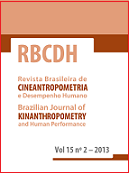Methods for assessing physical activity: a systematic review focused on older adults
DOI:
https://doi.org/10.1590/1980-0037.2013v15n2p256Abstract
Among the large array of instruments for measuring physical activity (PA), the use of questionnaires, pedometers, and accelerometers with older adults is frequent. This study aimed to analyze the most widely adopted protocol for each instrument that is most commonly used to assess PA in older adults, and explore possible advantages and disadvantages of the methods used for these instruments. Thereby, we performed a search in databases and cross references of the articles selected. This procedure yielded in 16 studies being included. The in-depth analyzed studies demonstrate that questionnaires are usually applied either as an interview or self-administered, assessing the domains of leisure, sports, and household chores with a recall period of a typical week in the last month. Regarding pedometers and accelerometers, the length of time considered to be sufficient for data collection is five days. The devices are frequently used on the waist or hip with a belt or attached to clothing and removed only for water activities or during sleeping time. The use of either instrument should take into account the advantages and disadvantages that influence choosing one over the other, such as the number of participants to be evaluated, the time available for assessment, among others. The use of accelerometer along with PA questionnaire may yield more reliable and accurate measurements of PA level. In addition, it is recommended that, for older adults, questionnaires should be applied employing the interview format, in order to minimize possible misinterpretation of the questions.



